INSIGHT by Mikaela Weisse, Elizabeth Goldman and Sarah Carter. Data created and updated by Peter Potapov, Svetlana Turubanova and Sasha Tyukavina – University of Maryland’s GLAD lab. This article was first published by the World Resources Institute. This section of the Forest Pulse is updated annually using annual tree cover loss data to provide a comprehensive overview on where forests have been lost around the world. Annual updates are released each year and cover the previous year’s trends.
Between 2022 and 2023, Brazil and Colombia experienced a remarkable 36% and 49% decrease in primary forest loss, respectively. Yet despite these dramatic reductions, the rate of tropical primary forest loss in 2023 remained stubbornly consistent with recent years, according to new data from the University of Maryland’s GLAD lab and available on WRI’s Global Forest Watch platform.
As some countries show political will to reduce forest loss and others do not, the frontiers of forest loss are shifting: the notable reductions in Brazil and Colombia were counteracted by sharp increases in forest loss in Bolivia, Laos and Nicaragua, and more modest increases in other countries.
Total tropical primary forest loss in 2023 totaled 3.7 million hectares, the equivalent of losing almost 10 football (soccer) fields of forest per minute. While this represents a 9% decrease from 2022, the rate in 2023 was nearly identical to that of 2019 and 2021. All this forest loss produced 2.4 gigatonnes (Gt) of carbon dioxide emissions in 2023, equivalent to almost half of the annual fossil fuel emissions of the United States.

Why Do We Focus on Tropical Primary Forests?
Though the tree cover loss data from the University of Maryland has global coverage, Global Forest Watch primarily focuses on loss in the tropics because that is where more than 96% of deforestation, or human-caused, permanent removal of forest cover occurs. This piece largely focuses on primary forests in the humid tropics, which are areas of mature rainforest that are especially important for biodiversity, carbon storage and regulating regional and local climate effects.
There are just six years remaining until 2030, by which time leaders of 145 countries promised to halt and reverse forest loss. While the declines in forest loss in Brazil and Colombia show promise towards that commitment, it’s clear that the world is falling far short of its targets.

| The Many Benefits of Forests
Forests are critical ecosystems for fighting climate change, supporting livelihoods and protecting biodiversity.
Climate: As the world faces a “final warning” on the climate crisis, reducing deforestation is one of the most cost-effective land-based measures for mitigating climate change. Forests are both a sink and a source for carbon, removing carbon dioxide from the air when standing or regrowing and emitting it when cleared or degraded.
Human well-being: Some 1.6 billion people, including nearly 70 million Indigenous Peoples, rely on forest resources for their livelihoods. Deforestation, especially in the tropics, also impacts local temperatures and rainfall in ways that can compound the local effects of global climate change, with consequences for human health and agricultural productivity.
Biodiversity: Forests harbor the most biodiversity of any ecosystem on Earth, and in turn, species that live within forests play an important role in maintaining healthy ecosystems and resources and services that people depend on.
Here’s a deeper look at some of the trends in forest loss in 2023:
| Dramatic reductions in primary forest loss in Brazil and Colombia coincide with political changes
Brazil
Brazil lost 36% less primary forest in 2023 than in 2022, hitting its lowest level since 2015. That decline translates to a dramatic decrease in Brazil’s share of total primary forest loss in the tropics — from 43% of the tropical total in 2022 to only 30% of the total in 2023.
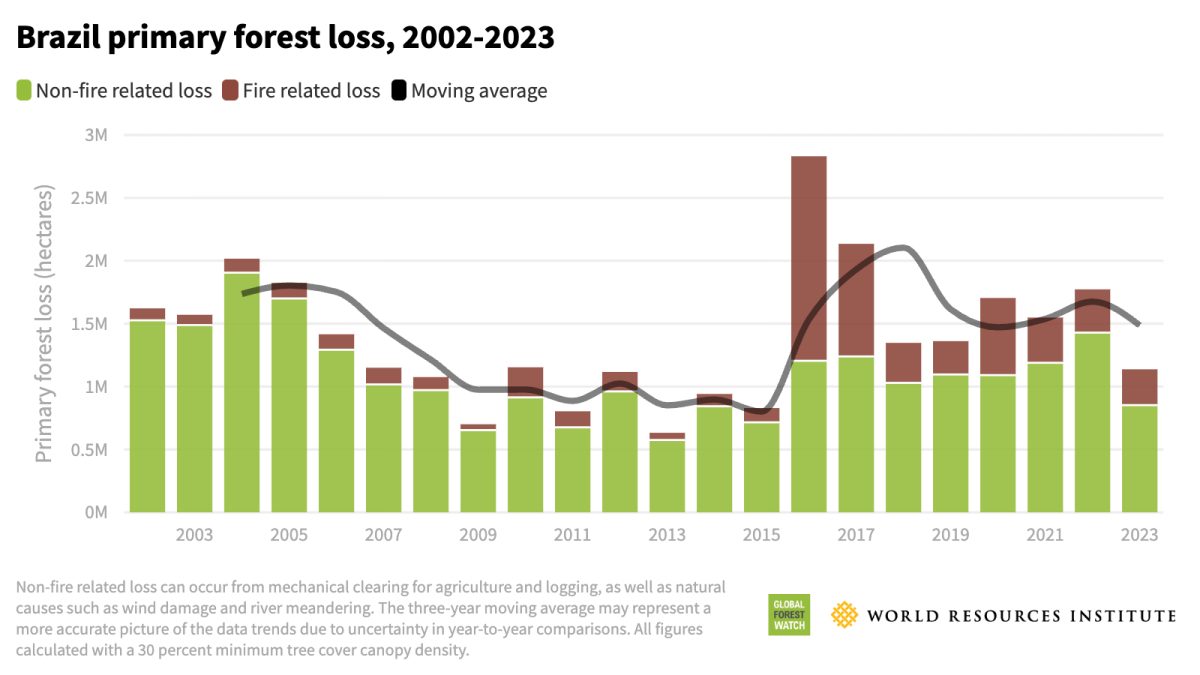
The Amazon biome experienced the largest decline, with 39% less primary forest loss in 2023 than in 2022. This is largely consistent with official government figures, which found a 22% decrease in Amazonian deforestation from 2022 to 2023 (read more about how the GFW data compares to Brazil’s official data). As the world’s largest rainforest, the Amazon holds outsized importance for global biodiversity and climate change mitigation.
The reduction in forest loss coincides with the transition of government leadership from President Jair Bolsonaro to President Luiz Inácio Lula da Silva, known as Lula, at the beginning of 2023. During Bolsonaro’s tenure, his administration eroded environmental protections and gutted enforcement agencies. In contrast, Lula has pledged to end deforestation in the Amazon and other biomes by 2030, and already had a proven track record on this issue from his previous administration.
Since his reelection, President Lula has taken action to reduce forest loss, including revoking anti-environmental measures, recognizing new Indigenous territories, and bolstering law enforcement efforts (though some enforcement employees are currently on strike, saying they are overworked and undercompensated). These changes appear to be having an impact on the rate of forest loss, though it still remains higher than its low point in the early 2010s.
This positive news comes at a time when the Amazon is experiencing its worst drought on record. Though forest loss from fire did not increase in the Brazilian Amazon as a whole in 2023, the area surrounding the city of Manaus saw unprecedented fires, and the state of Roraima experienced a record-breaking number of fires in February 2024. Concern is growing that feedback loops between deforestation, warming temperatures and drought could result in a “tipping point” beyond which parts of the Amazon can no longer support rainforest and would turn into savannah.
And not all biomes in Brazil saw the reduction in forest loss seen in the Amazon: both the Cerrado and Pantanal biomes saw increased forest loss in 2023.
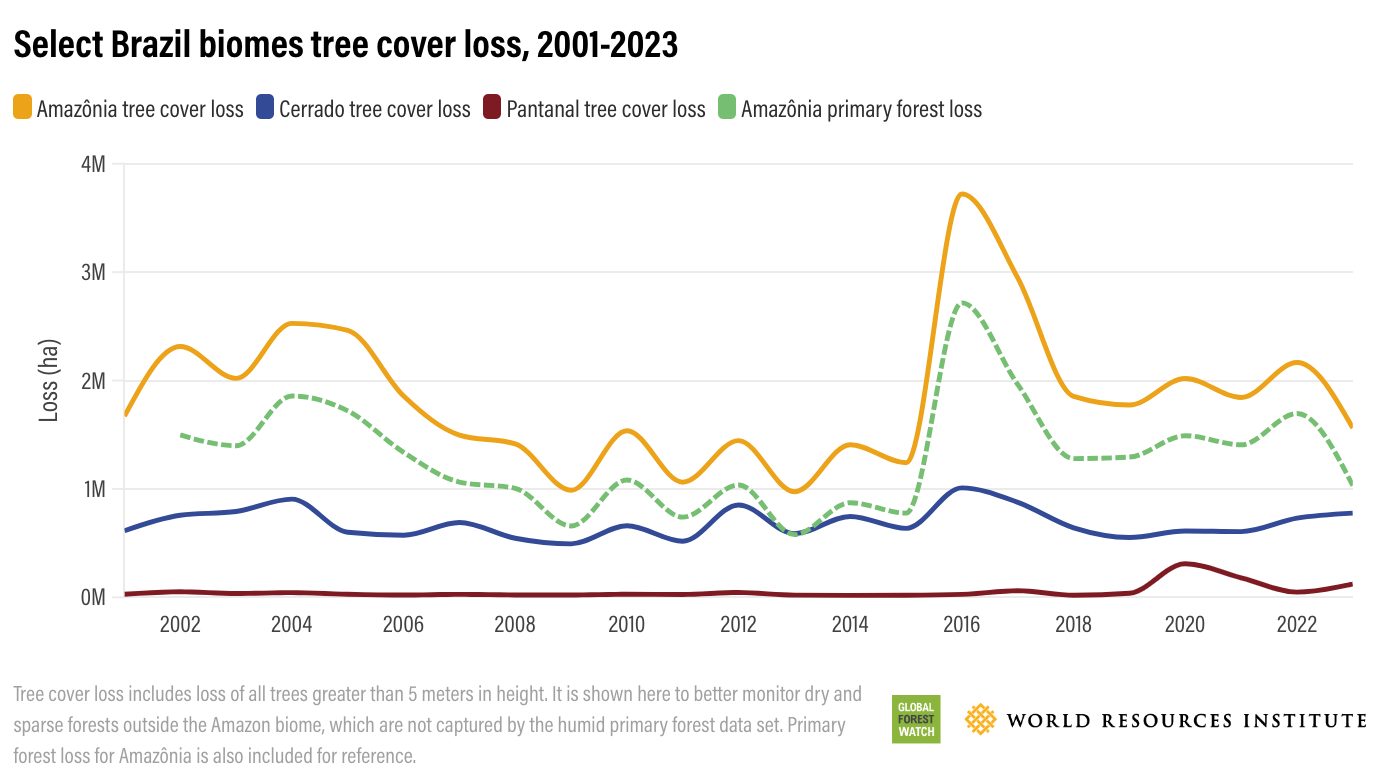
The Cerrado biome, a tropical savannah to the southeast of the Amazon, experienced a 6% increase in tree cover loss1 from 2022 to 2023, continuing a five-year increasing trend. The Cerrado is the epicenter of agricultural production in the country and the extent of its soy production has more than doubled over the past 20 years. Civil society organizations are calling on companies to commit to deforestation and conversion free farming as a way to ensure that their supply chains are not contributing to ecosystem loss in this valuable biome.
Meanwhile, the Pantanal biome, the world’s largest tropical wetland, experienced a spike in forest loss in 2023 due to fires. Fire is a normal feature of this ecosystem, however, a multi-year “megadrought” caused in part by climate change has resulted in repeated burning over large areas, which has experts worried about the ability of this ecosystem to recover.
Colombia
Colombia also experienced a dramatic decline in primary forest loss in 2023, with a 49% reduction in primary forest loss compared to 2022.
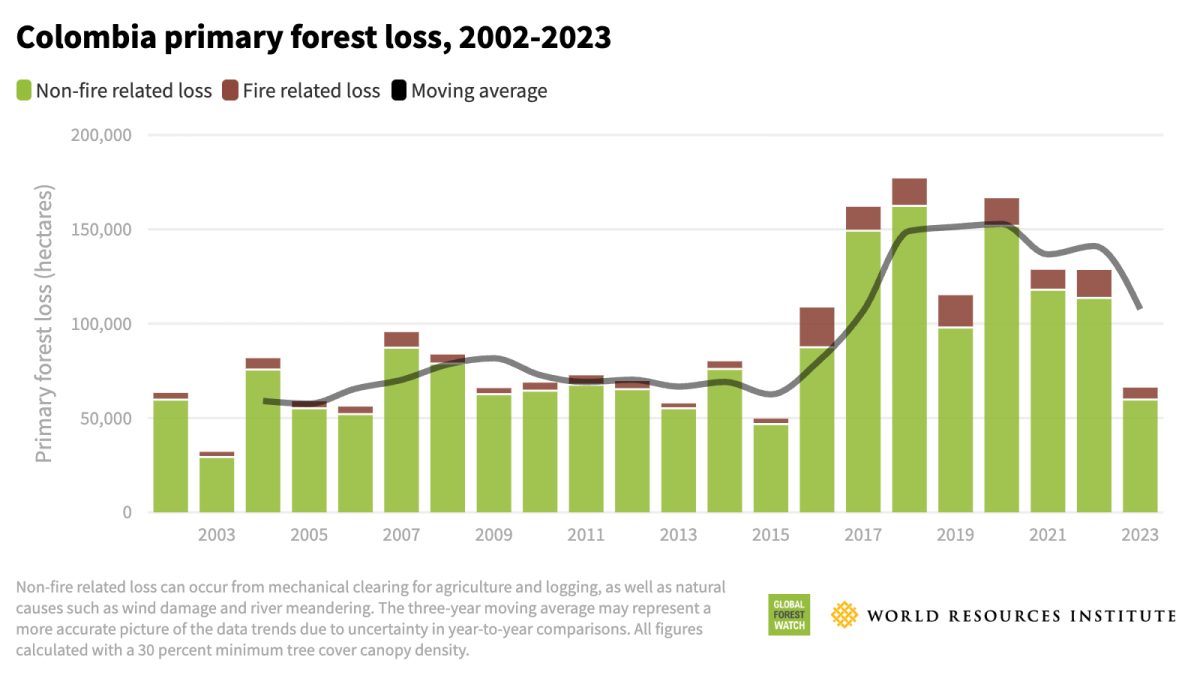
Colombia’s rate of primary forest loss increased significantly starting in 2016, coinciding with the country’s peace agreement with the Revolutionary Armed Forces of Colombia (FARC). That agreement included resettling FARC members to new areas, leaving accessible large tracts of remote forests where they previously maintained strict control over land use. As a result, clearing by other armed groups and land speculators increased. The new figures for 2023 indicate a possible return to pre-peace agreement levels of forest loss.
Like Brazil, Colombia also recently experienced a change in leadership, inaugurating President Gustavo Petro Urrego in August 2022. His administration focuses on the environment, rural reform and peace to bring better quality of life for people. As part of those efforts, President Petro’s government is negotiating with different armed groups, with forest conservation as an explicit goal of the discussions. One of the armed groups currently in the negation process, the Estado Mayor Central (EMC), included penalties on forest clearing as a “gesture of peace.” However, it is unclear when or if negotiations will reach a final peace agreement with each of these groups.
Local communities have also been promoting the sustainable management of natural resources and the conservation of forests.
Not all tropical countries have seen reductions in primary forest loss like Brazil and Colombia. Bolivia, Laos and Nicaragua all experienced rapid increases in forest loss in 2023, largely due to fires (in the case of Bolivia) and expansion of agricultural land.
Bolivia
In Bolivia, primary forest loss increased by 27%, reaching its highest year on record for the third year in a row. Bolivia had the third most primary forest loss of any tropical country, despite having less than half the forest area of either the Democratic Republic of the Congo or Indonesia.
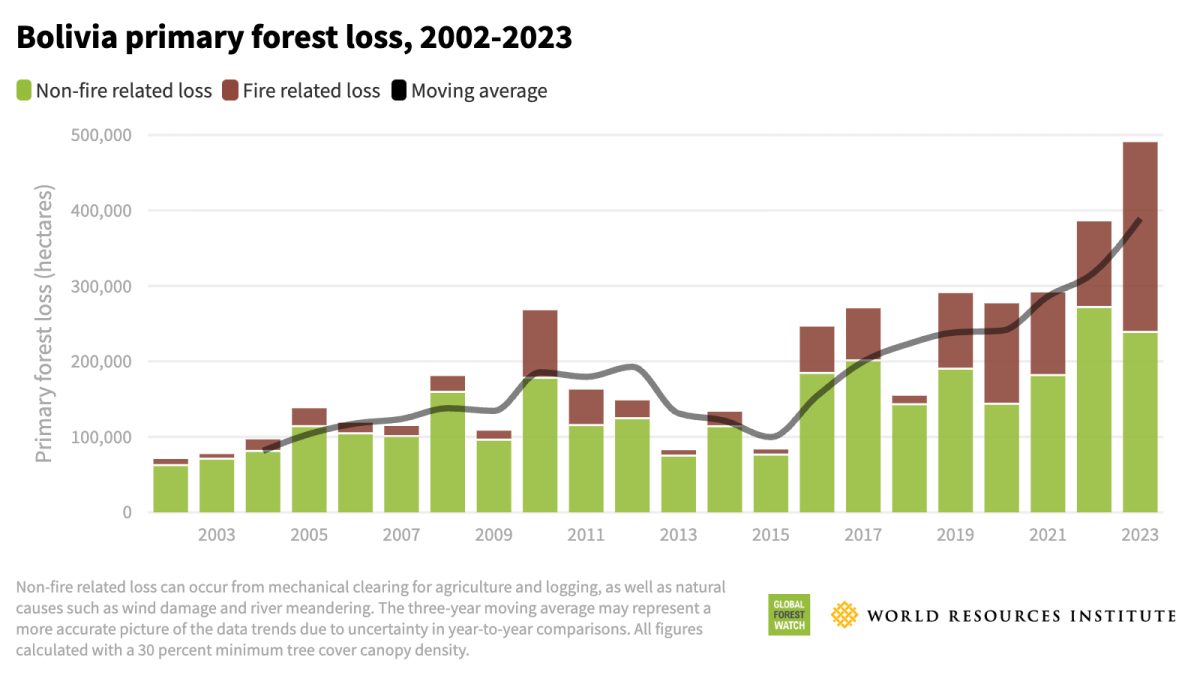
Fire continues to play a major role in the country, accounting for just over half (51%) of the primary forest loss in 2023. Forest fires in tropical nations like Bolivia are usually set by humans for agricultural purposes, such as regenerating grasslands for grazing and clearing for cropland, or to claim land. Under hot and dry conditions, those fires can spread out of control into forested areas. Bolivia experienced record-breaking heat in 2023 due to the combination of human-caused climate change and the natural El Niño phenomenon. In 2023, forest loss due to fire was most prevalent in the department of Beni, which experienced more than double its rate of primary forest loss from 2022. Forest fires again were prevalent within Noel Kempff Mercado Park and other protected areas in the country.
Agricultural expansion was the other major driver of primary forest loss in Bolivia. Soy expansion has resulted in nearly a million hectares of deforestation in the country since the turn of the century, nearly a quarter of which can be attributed to Mennonite colonies. Though Bolivia has much less soy production than neighboring countries, most of its expansion has come at the expense of forests. The government continues to promote the agribusiness industry by setting ambitious targets for soy and beef exports, promoting the expansion of biodiesel and subsidizing agricultural activity.
| New hot spots of forest loss in Bolivia in areas ravaged by fires
New hot spots of forest loss in Bolivia in areas ravaged by fires
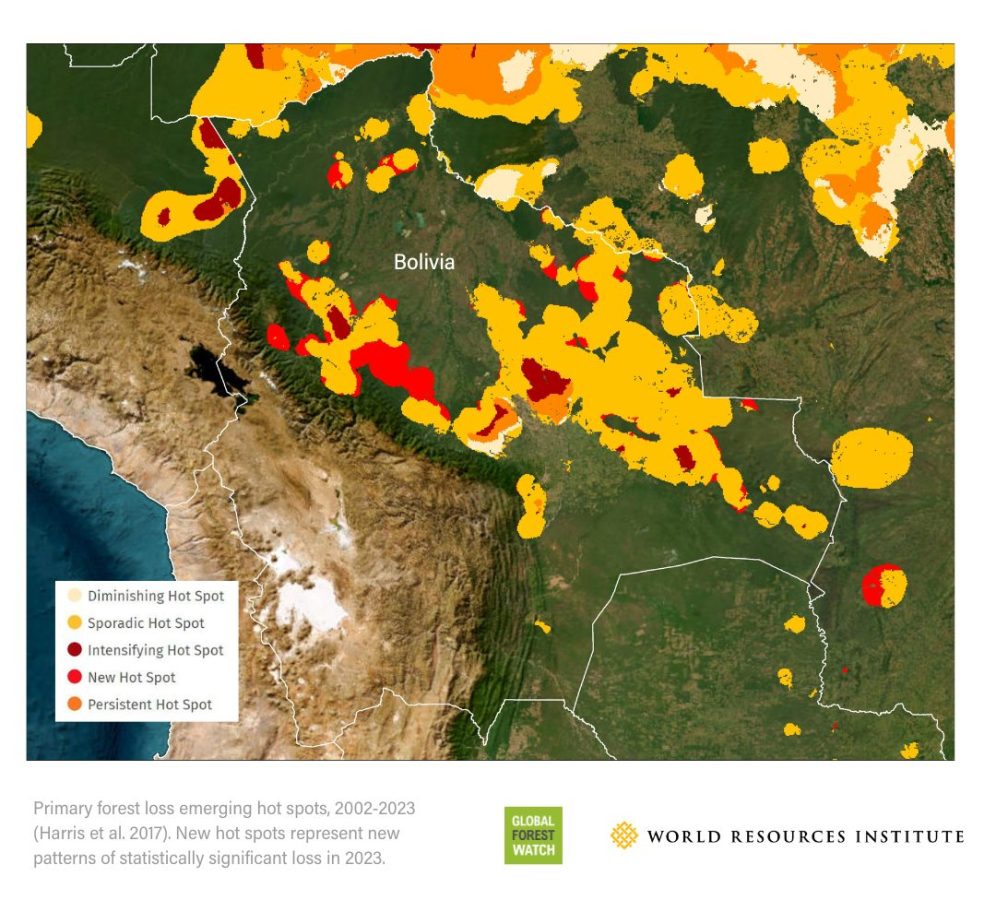
Laos
Laos also experienced its highest rate on record (since 2001) of primary forest loss in 2023, with a 47% increase from an already record-high in 2022. In 2023 alone, 1.9% of Laos’ remaining primary forests were lost, a rate of loss that’s 5 times faster than Brazil’s proportional to its forest area.
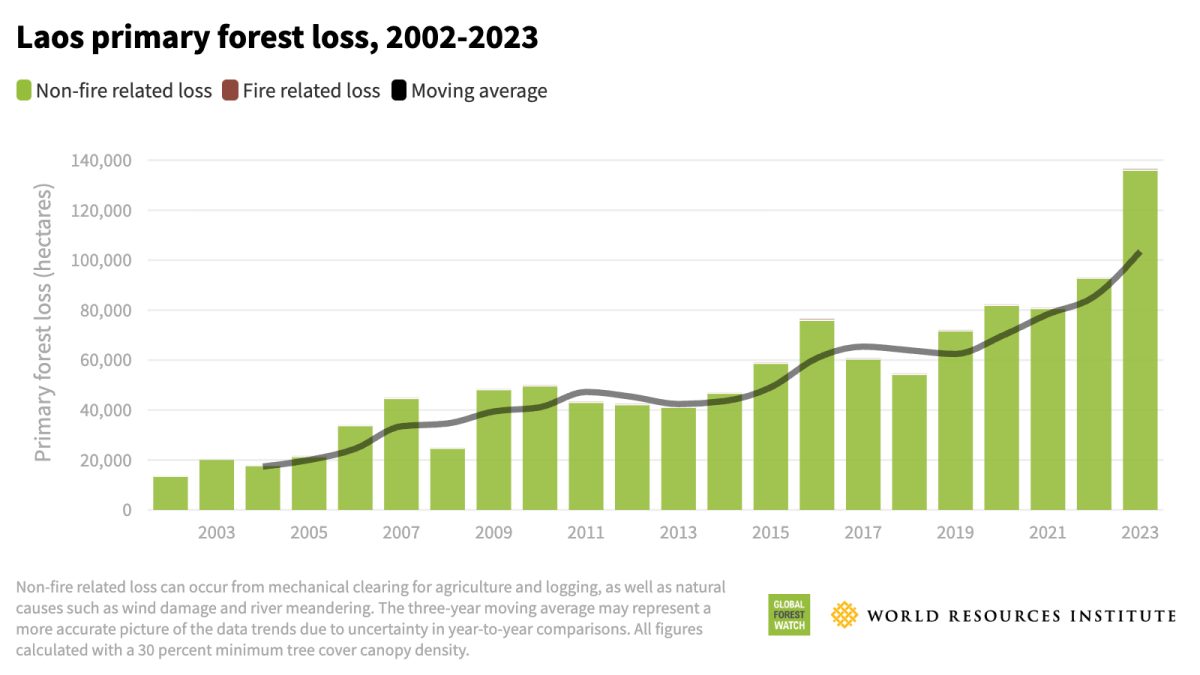
Nicaragua
Nicaragua has also seen an increase in primary forest loss in 2023 and recent years, with 60,000 hectares lost in 2023. While the country had the eleventh highest area of primary forest loss in the tropics in 2023, it had the highest rate of primary forest loss relative to its size,2 losing 4.2% of its remaining primary forest in a single year.

The expansion of agriculture and cattle ranching is the main cause of forest loss in Nicaragua. Gold mining is also a driver: the area of mining concessions has also nearly doubled since 2021 to cover around 15% of the country. Beef and gold are both major exports for Nicaragua, with much of their production bound for the United States. In many cases, deforestation has been accompanied by violent land invasions in Indigenous territories. Sources say the government is complicit in deforestation and land invasions, also shuttering environmental and Indigenous advocacy groups in the country.
Persistently high rates of primary forest loss in the Democratic Republic of the Congo (DRC) are cause for concern. The Congo Basin is the last major tropical forest that remains a carbon sink, meaning the forest absorbs more carbon than it emits. Most Congo Basin countries experience consistently low levels of primary forest loss, such as Gabon and the Republic of the Congo — both High Forest Low Deforestation (HFLD) countries — which continued to see low levels in 2023. However, more than half of the Congo Basin’s forest is located in DRC, which is losing half a million hectares of primary rainforest each year. And while the rate in 2023 increased by only 3%, the continued small increases over many years are adding up.
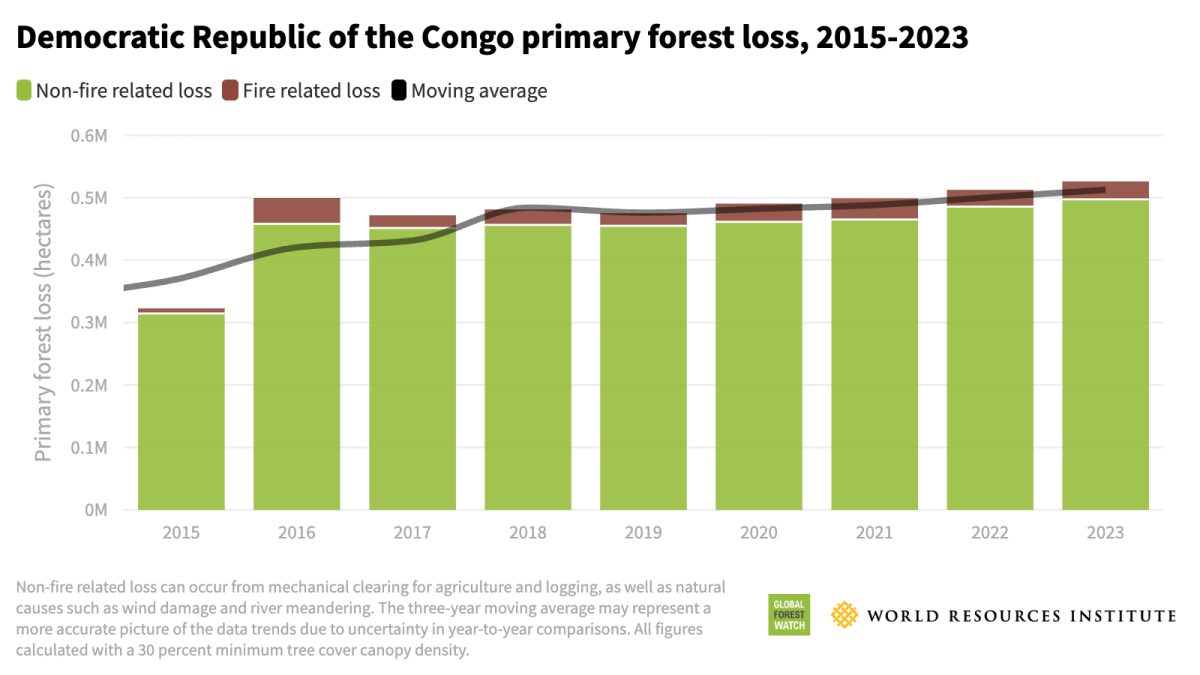
The drivers of loss in DRC are predominantly shifting cultivation (where land is cleared and burned for the short-term cultivation of crops and left fallow for forests and soil nutrients to regenerate) and charcoal production, the dominant form of energy in the country (generated by cutting and burning timber). Poverty is widespread and access to electricity is limited — about 62% of the population lives on approximately US$2 a day and 81% does not have access to electricity — with local populations relying on forests for food and energy demands.
The rate of primary forest loss was higher in the eastern part of DRC, where new hot spots of loss appeared in 2023. Armed groups have impacted this region for more than two decades by selling timber and other forest products to fund their operations, harming local populations. Additionally, approximately 5.6 million people have been displaced and survive by clearing the forest for fuel and to open land for agriculture.
New hot spots show expansion of forest loss frontiers in eastern Democratic Republic of the Congo
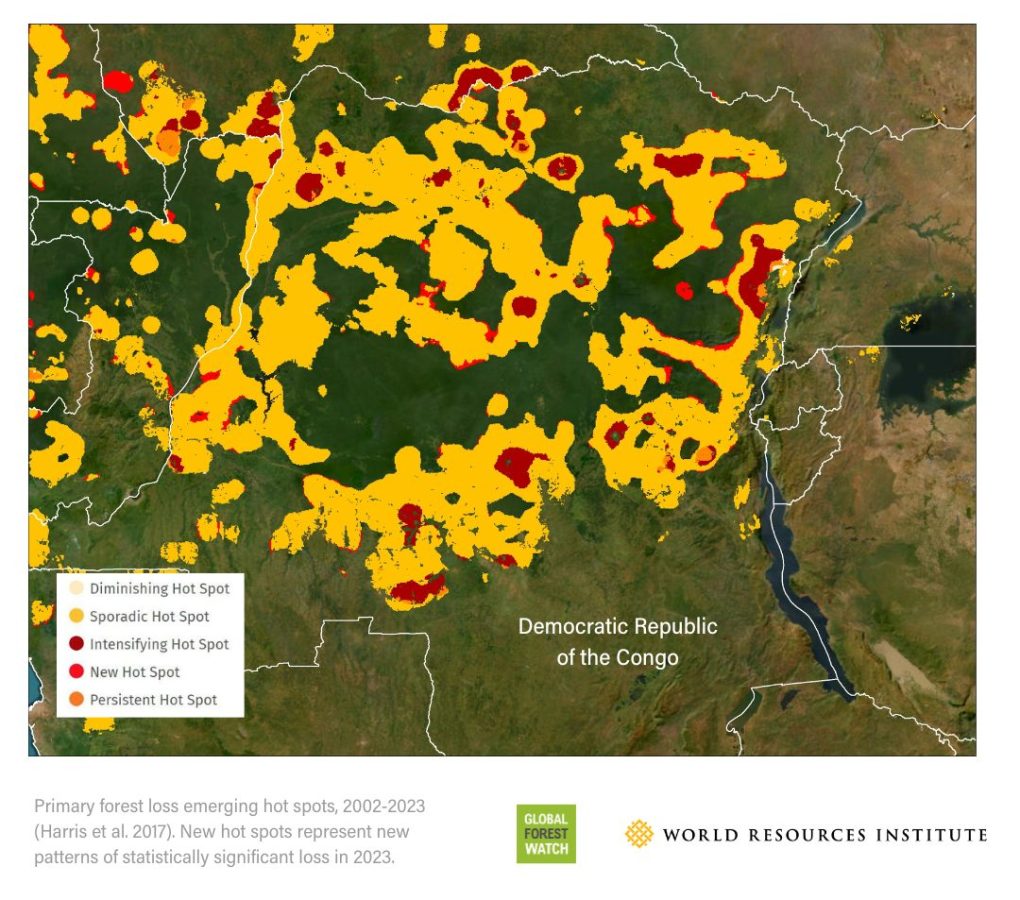
Another driver of primary forest loss seen in DRC in 2023 was artisanal and semi-industrial mining. Though a relatively small driver of forest loss, mining that is not conducted responsibly can contribute to deforestation and degradation at local scales, as well as to human rights abuses for workers and other negative impacts to communities and ecosystems.
While high rates of primary forest loss continue, the government of DRC has promised to invest in an economy not based entirely on resource exploitation. Work as part of the New Climate Economy is set to commence in 2024, which promises resources to protect DRC’s forests and enable the economic transformation needed to reduce pressure on forests.
Indonesia experienced a 27% uptick in primary forest loss in 2023, an El Niño year, though the rate remains well below that of the mid-2010s.
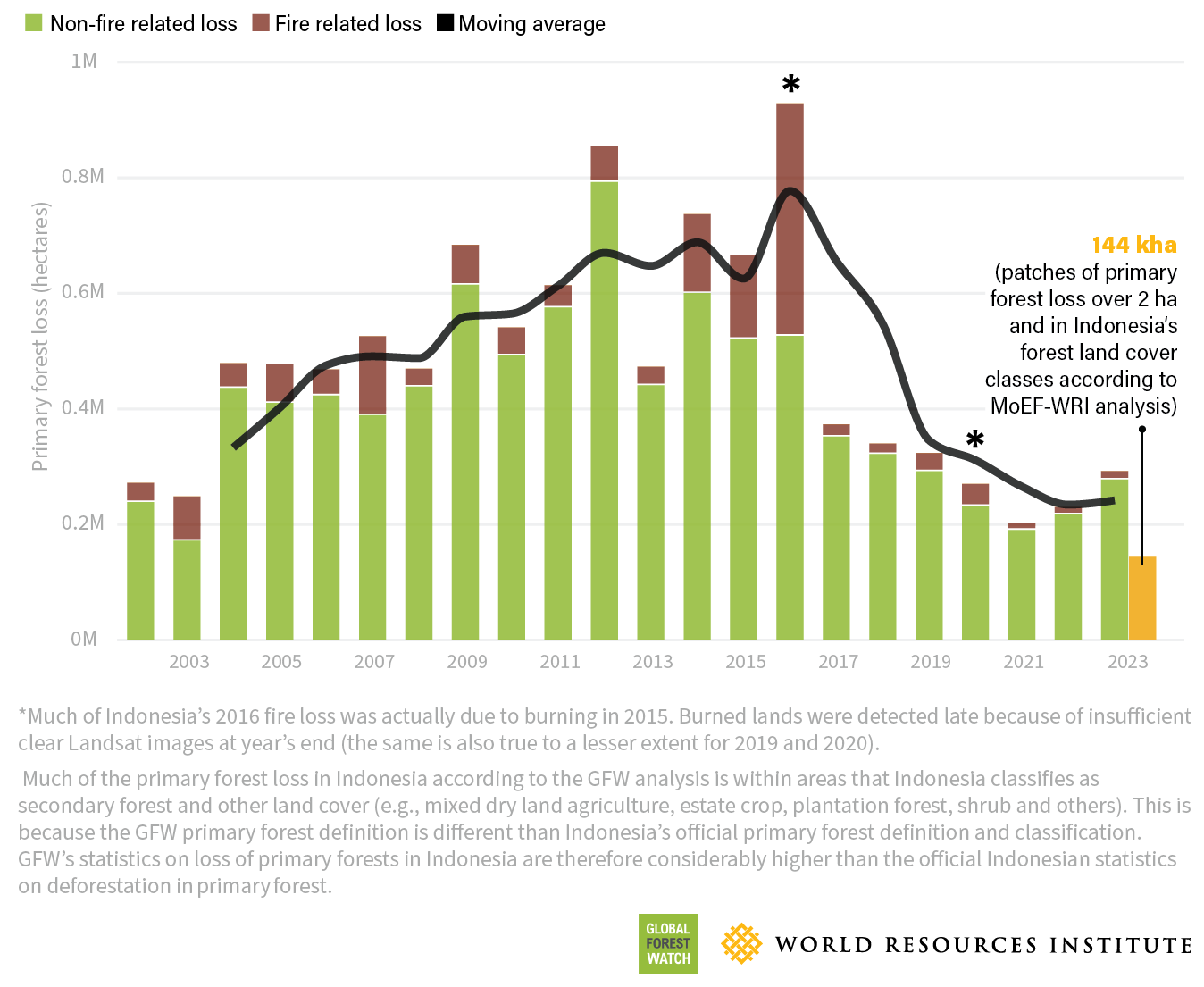
Much of the primary forest loss in Indonesia according to the GFW analysis is within areas that Indonesia classifies as secondary forest and other land cover (e.g., mixed dry land agriculture, estate crop, plantation forest, shrub and others). This is because the GFW primary forest definition is different than Indonesia’s official primary forest definition and classification. GFW’s statistics on loss of primary forests in Indonesia are therefore considerably higher than the official Indonesian statistics on deforestation in primary forest.
The emergence of El Niño conditions led to concerns that Indonesia might experience another fire season like 2015; however, fires in 2023 had a less severe impact than initially predicted. In rural areas, fire is used to clear land for agriculture and can escape beyond property boundaries into trees and peat soils, releasing stored carbon into the atmosphere. Wetter conditions than the 2015 El Niño and investments made by the government in fire prevention capabilities, as well as efforts to suppress fire by local communities, all contributed to a quieter than expected fire season.
Primary forest loss in patches greater than 100 hectares made up 15% of the loss in Indonesia in 2023. The expansion of industrial plantations took place in several locations adjacent to existing oil palm and pulp and paper plantations in Central Kalimantan, West Kalimantan and West Papua. According to the Ministry of Environment and Forestry, this expansion occurred in concessions granted prior to 2014 when the current administration took office.
Small scale primary forest loss was also prevalent throughout the country in 2023. Small clearings for agriculture contributed to ongoing losses within several protected areas, including Tesso Nilo National Park and Rawa Singkil Wildlife Reserve. Other losses linked to mining could be seen in Sumatra, Maluku, Central Kalimantan and Sulawesi.
As in previous years, the global trend in tree cover loss depends largely on annual fire dynamics in boreal forests. 2023 saw a 24% increase in global tree cover loss, from 22.8 million hectares in 2022 to 28.3 million hectares in 2023, which can entirely be explained by a huge increase in fire-driven tree cover loss in Canada. In the rest of the world, tree cover loss decreased overall by 4%.
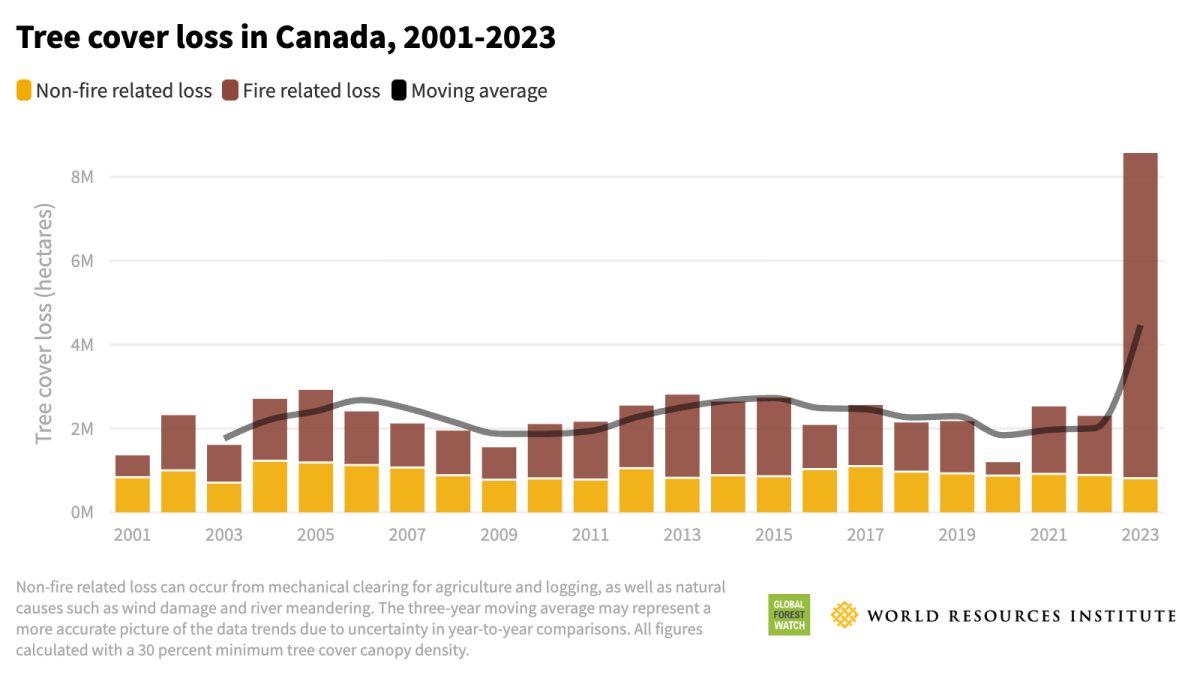
Like in many areas of the world, extensive drought and increased temperatures driven by climate change were widespread across Canada. This led to the worst fire season on record, with a 5-fold increase in tree cover loss due to fire between 2022 and 2023. High temperatures create dry and extremely flammable fuel for fires, meaning that fires are more likely to start, and also more likely to turn into megafires.
While fires can be a natural part of the ecosystem in northern forests and the forests can often regrow, more intense and more frequent fires can lead to permanent changes to forests. Smoldering fires can also persist below the ground and reignite again, causing more damage.
The consequences of Canada’s 2023 fires also go beyond forests — resulting in destroyed homes and fatalities, and temporarily causing some of the worst air quality in the world across some of the most populous parts of Canada and the United States.
The data from 2023 demonstrates that countries can cut rates of tropical forest loss if they garner the political will to do so, and the countries that have accomplished this can provide lessons for others. However, past experience in Brazil shows that such progress can be reversed when political winds change.
Enduring incentives and financial mechanisms that place a value on standing forests are needed to make forests less vulnerable to depletion from farms, mines, infrastructure or other economic activities. REDD+ and other performance-based payment mechanisms can provide a financial incentive for forest protection and restoration by valuing forest carbon, and regulatory or voluntary measures to eliminate deforestation from commodity supply chains can help to counter economic drivers of tropical deforestation. Investments in the bioeconomy can also lead to progress on reducing deforestation while promoting economic growth and ensuring the livelihoods of those who rely on forests.
Ultimately, solutions that are truly adapted to the local context, alongside global solutions for climate change and sustainability, must work hand in hand to reduce forest loss everywhere.
Explore the data yourself on Global Forest Watch
1. Note that here we use “tree cover loss” rather than “primary forest loss” because the primary forest data available for this analysis is for humid tropical forests and does not cover drier ecosystems like the Cerrado. The loss captured in this statistic includes all loss, including in secondary vegetation and plantations.
2. Of countries with at least 1 million hectares of tropical primary forest in 2001.
| All opinions expressed are those of the author and/or quoted sources. investESG.eu is an independent and neutral platform dedicated to generating debate around ESG investing topics.









